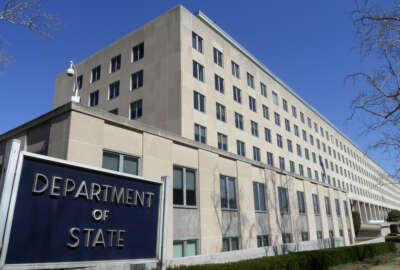An old and essential federal process gets a revamped website
The General Services Administration recently overhauled its regulations.gov website, the site where Americans can go to comment on proposed federal regulations.
Best listening experience is on Chrome, Firefox or Safari. Subscribe to Federal Drive’s daily audio interviews on Apple Podcasts or PodcastOne.
The General Services Administration recently overhauled its regulations.gov web site, the site where Americans can go to comment on proposed federal regulations. The new features strengthen the integrity of commenting, an important component in rule-making. For more on the ongoing work to modernize rulemaking, Federal Drive with Tom Temin turned to the Deputy Associate Administrator for the Office of Regulation Management at the GSA, Virginia Huth.
Interview transcript:
Tom Temin: Ms. Huth, good to have you on.
Virginia Huth: Thank you so much.
Tom Temin: Let’s start with the website itself where people can go, one of the issues in rulemaking, which is allowed, is mass submission of identical rules. And people have been doing that for a long time to kind of give weight to their point of view. But you’ve got some safeguards now to ensure that it’s people posting and not bots. Tell us more about that.
Virginia Huth: Right. Well, the new regulations.gov site does include a better search engine user experience, and so forth. But I think the most exciting thing is that addresses concerns about fraudulent comments, sometimes called fake comments, which are comments that are submitted under false identities. Now, what’s kind of interesting is that federal rulemaking decisions aren’t based on the number of comments nor on the authors of the comments, but rather the substance of the comments. It’s not about voting your opinion when it comes to federal rulemaking. However, there is a growing risk of fraudulent comments driven by bad actors who seem to want to manipulate or distort the rulemaking process. And these bad actors threaten the public’s perception of the integrity of the rulemaking process reducing trust in government. There were several high profile rulemaking some years ago that received, I think, even 22 million comments, and most of them weren’t authentic. So it creates a bad look for the government. But it also contributes to the already huge workload for agencies in processing these massive volumes of comments, what we we call mass comments, they simply still have to read through them because they are comments. And that just can be a huge waste of time. So most of these fake comments are submitted via electronic bots. And there really is no way to know whether these bots are authorized by real people, or simply fabricated This is because while many bots used by bad actors, lots of legitimate organizations, advocacy groups and so forth, will also bundle comments from the members with their approval and permission and submit them electronically. It’s basically the digital version of a postcard campaign that we might have seen 20 years ago. So GSA’s solution is two pronged. The first is implementation of ReCAPTCHA. And I’m sure everybody’s seen the checkbox if you’re a real person feature, which is backed up by clicking on the buses, and the streetlights, and so forth. So that prevents bots, whether they’re legitimate or from bad actors from submitting comments. Then we had to figure out how to let the good guys and because advocacy organizations are interested, and they have an important role in our society. So what we did was we created a second part, a comment application programming interface, or a comment API, for use only by the authorized entities. So any organization or person can request an API key from GSA. This is a digital key, but before the key is activated, GSA validates that the entity is who they say they are basically through use of a commercial identity validation service. So once we verify their identity, then we turn on the key. And then they can use the service to submit the comments legitimately with their organization’s members permissions. And the thing is, is we can also now trace the source of those comments to a particular organization or individual if there turn out to be any concern.
Tom Temin: Let me ask a scenario here. Suppose the FDA proposes a rule for dental picks, and all 20 million dentists decide they want to weigh in on it through their association, I’m making this up. Is it possible for say that API to be granted to the association of dental pick users or whatever it might be — but can they submit something once and say, by the way, this represents 20,000 members or 20 million members so that you don’t need to get 20 million identical submissions, but the rule maker would know that 20 million people weighed in or 20,000.
Virginia Huth: Right, right. Absolutely. And in fact, it’s very common for an association to submit comments on behalf of their membership, say we represent the association of dental pick professionals and our 20,000 members support this. And that often happens. But sometimes organizations really like to produce the mass comments. Perhaps there’s a sense that there’s more bang in the same way that a box of postcards landing on your desk 20 years ago might have made an impression. But it’s really up to agencies how they treat those that’s up to them, that we support all of that.
Tom Temin: And let’s zoom out a little bit here to the modernizing of rulemaking in general, because it’s been cited in the United States as kind of the gold standard for the world with respect to administrative procedure, and being fair to citizens affected by the rules. What else is going on after you have updated the input process at regulations.gov?
Virginia Huth: So regulations.gov is the external site. It’s where the public can submit comments on proposed regulations. And that’s really critical, that openness and transparency. But it’s also part of a larger program known as E-Rulemaking. E-Rulemaking moved over to GSA October 2019, from EPA. And so E-Rulemaking also manages an agency facing system known as the Federal Docket Management System, or FDMS. And docket is basically a fancy word for file. So it supports over 40 agencies and all their sub components, pretty much most of the federal rulemaking agencies, but a couple of agencies do have their own systems. So what we want to do is modernize FDMS, it needs to catch up to the public side. We issued a request for information in January to hear from our agency partners on approaches to maintaining and optimizing our current technology stack as well as pursuing the full scale modernization.
Tom Temin: And is there a way for agencies that make a decision to move a rule from proposed to final so that the public and everyone else can see the reasoning and what evidence they use to go to final?
Virginia Huth: Yes. That’s part of the rulemaking process. And in the docket system, there’s typically evidence related to the contracting decision, if there are any studies. The comments are often publicized on the front page again of regulations.gov so people can see other comments. And then ultimately, as an agency finalizes its rule making, there’s a preamble, and the preamble is the important place where the agency will usually summarize the comments and why they made one decision versus another.
Tom Temin: And I guess the other question arises, maybe this is more philosophical than functional. And if a rule is proposed, and one person, one entity weighs in favor, and 20,000 weigh against, as you mentioned earlier, it’s not a plebiscite, it’s not a vote. It’s just an administrative procedure. But do agencies, do you think, ever take into account that maybe the cost benefit that we thought is not right. At least 20,000 people actually turns out they’re right, and maybe the one guy whose benefit is wrong — and can that happen? And does it happen?
Virginia Huth: Right, so you’re entirely right that it’s not a plebiscite. And if you just send in a letter with your opinion, as opposed to this is why it’s a bad idea, or this is its impact on me, it’s not going to hold a lot of weight. That being said, if a preponderance of comments come in that can affect the outcome of the regulation, because it also says this is affecting a lot more people or a lot more groups than we thought it did. So it’s not completely without weight to have a large volume of comments affect the outcome of the rulemaking. In that sense, one significant and meaningful comment will probably outweigh hundreds of comments that just say this is a bad idea.
Tom Temin: Present facts and ideas and not just simply drop this. And are there other modernizing efforts for rulemaking that might take congressional action, or maybe some update to the Administrative Procedures Act? Is that something that you’ve run into at this point?
Virginia Huth: I have not really thought much about updates to the Administrative Procedure Act. It really is a pretty robust set of guidelines for the rulemaking process. However, as we are looking to modernize FDMS, we are looking at some pretty exciting opportunities I want to say, first off, customer service is our North Star and innovation is our compass. So as we’re looking to modernize FDMS, we’re looking at really innovative ways to be more flexible, use more scalable architecture. But the really exciting part is looking to support data analytics tools. There are three major goals overall to the modernization. One is, we do want to support government efficiency and accountability, just like we talked about to the Administrative Procedure Act. At the same point, we want to promote transparency in the rulemaking process for the public. And then finally, we want to save taxpayer dollars with improved operational efficiency down the road, because the system is so costly to maintain. But back to that government efficiency and accountability. There’s this vast regulatory framework that is incomprehensible by a single individual. The result is a somewhat stove piped approach to regulation, which can result in regulations and one agency being developed without awareness of the impact on regulations on other parts of government. Right now there is coordination, but it’s managed by humans who have to connect the dots. But new data analytics technology would really help us identify new opportunities for coordination across domains opportunity for streamlining, to help find areas of duplication or even contradiction in rulemaking,
Tom Temin: That could even help within an agency like EPA. If they do something in air, there might be something affected in water and they didn’t talk to each other.
Virginia Huth: Exactly. Sometimes I think there’s the Army Corps of Engineers, EPA, the Department of Interior, there’s water issues, hazardous issues, that cross-cut agencies.
Tom Temin: Virginia Huth is Deputy Associate Administrator for the Office of Regulation management at the GSA. Thanks so much for joining me.
Virginia Huth: It’s been my pleasure Tom, thank you so much.
Copyright © 2025 Federal News Network. All rights reserved. This website is not intended for users located within the European Economic Area.
Tom Temin is host of the Federal Drive and has been providing insight on federal technology and management issues for more than 30 years.
Follow @tteminWFED
Related Stories





